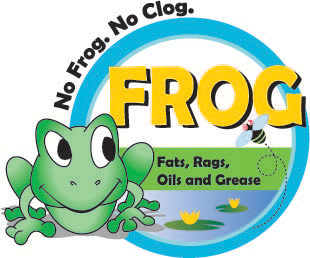 Help prevent sewer clogs in your neighborhood
Help prevent sewer clogs in your neighborhood
Sewage is used water and wastes discharged by a community and collected from the drains of sinks, showers, toilets and laundry facilities and flows into sewer lines, or collection systems, from the drains in homes and businesses. From the sewer lines, it is then transported to a sewage treatment facility.
Sewers back up when sewage collection lines get clogged by items flushed down toilets and drains such as
Fats,
Rags
Oil and
Grease (FROG) that get caught in the line and plug it up. In addition to the costly repairs, sewer back ups are messy, foul-smelling, and pose a serious public health threat.
- Only feces, urine and toilet paper should be flushed down the toilet.
- Other drains should be only used to dispose of used water and soaps from cleaning.
Never flush down the toilet or drain
Fats, cooking oil or grease
Motor oil
Disposable diapers and baby wipes
Disinfectant wipes
Cleaning cloths
Big chunks of garbage
Cat litter including “flushable” cat litter
Feminine napkins, tampons and applicators
Dye (hair /clothing) or tanning solutions
Flammable products (lighter fluid, acetone)
Acidic and toxic substances
Proper Disposal Tips
- Throw bulky waste materials in trash.
- Freeze small amounts of fats, oils and grease in a container with a tight-sealing lid and dispose of in trash.
- Mix oil with an absorbent material such as coffee grounds, place in a tightly-sealed container and dispose of in trash.
- Use a strainer in your sink to catch scraps.
- Cover drains with fine screen or catch basket.
